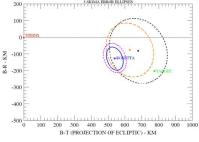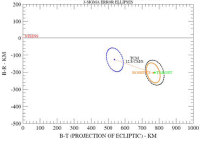No. 102 - Start of Optical Navigation Campaign
During the reporting period there were four slots for asteroid observations with the spacecraft's cameras on 4, 7, 11 and 14 August. Images acquired during these sessions have been used for the first time for navigation purposes. The accuracy and the consistency of the measurements exceeded early expectations and allowed them to be used already for the execution of the first trajectory correction manoeuvre (TCM) on 14 August.
A total of four New Norcia (NNO) and eight DSN station (DSS) passes were taken during this period:
| DOY | Date | Pass | Main Activity |
| 217 | 04/08/08 | NNO 1620 | Navigation slot 1 |
| 220 | 07/08/08 | NNO 1623 | Navigation slot 2 |
| 221 | 08/08/08 | DSS-54 1625 | Monitoring |
| 222 | 09/08/08 | DSS-54 1626 | Monitoring |
| 223 | 10/08/08 | DSS-54 1627 | Monitoring |
| 224 | 11/08/08 | NNO 1627 DSS-65 1628 |
Navigation slot 3 |
| 225 | 12/08/08 | DSS-65 1629 |
Monitoring |
| 226 | 13/08/08 | DSS-54 1630 | Monitoring |
| 227 | 14/08/08 | NNO 1630 DSS-55 1631 |
Navigation slot 4 and closest approach -3 weeks TCM |
| 228 | 15/08/08 | DSS-55 1632 | Monitoring |
At the end of the reporting period (DoY 228) Rosetta was at 314.5 million km from Earth (2.1 AU) and the one-way signal travel time was 1049 seconds. The distance to the Sun was 310.3 million km (2.07 AU). Asteroid Steins was at about 15.7 million km from Rosetta.
First Trajectory Control Manoeuvre (CA-3 weeks)
A series of trajectory control manoeuvres are performed leading up to the Steins fly-by in September. The first of these was successfully executed on DOY 227, three weeks before the closest approach (CA) to asteroid Steins:
| Closest Approach-3 weeks TCM | |
| Date |
14 August 2008 |
| Start of burn |
11:42 UT |
| Length of burn |
113 s |
| Fuel consumption |
142.28 g |
|
delta-V |
12.8 (cms-1) |
|
CA distance before TCM |
554.2 km |
|
CA distance after TCM |
792.4 km |
The delta-V of the TCM has adjusted Rosetta's trajectory such that the distance of the spacecraft relative to Steins at closest approach shifted from 554.2 km to 792.4 km (Figure 5). This is now very close to the target distance of 800 km, which is set by the fly-by conditions to be compatible with spacecraft performance.
Several more slots are set between now and 4 September for possible future manoeuvres, should they be required. For more details on the manoeuvres see also: "Rosetta fine-tunes its approach to asteroid Steins," linked from the right-hand side navigation.
Optical Navigation Campaign
To help determine the required delta-V of the TCM, images of the asteroid gathered by both the two navigation cameras (NAVCAM A & B) and the OSIRIS instrument, during the navigation slots in this reporting period, were used.
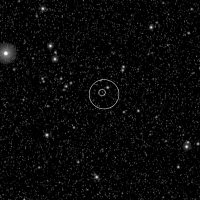 |
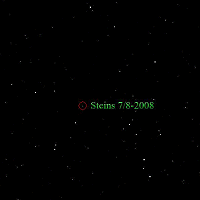 |
|
Figure 1. NAVCAM A image of asteroid Steins, 4 August 2008 |
Figure 2. OSIRIS images of asteroid Steins, 7 and 11 August |
The optical data from the 4, 7, 11 and 14 August navigation slots have resulted in a progressively better determination of the asteroid's location and the relative spacecraft position in the target plane of the flyby.
The post fit statistics of the data from all the acquired images is listed in the table below, separately for the right ascension and declination determination. Stated for the three cameras are: the total number of images obtained on these four days, the mean residual of the data to the last solution, and both the root mean square and standard deviation of the residuals.
| Optical Navigation post fit statistics (residuals in millidegrees relative to solution) | ||||
|
Right Ascension | ||||
| camera |
No. |
mean | root mean sq. | standard dev. |
| NAVCAM A |
18 |
0.016 |
0.241 |
0.241 |
| NAVCAM B |
24 |
-0.187 |
0.346 |
0.291 |
| OSIRIS |
10 |
0.005 |
0.048 |
0.048 |
| ALL |
52 |
-0.080 |
0.275 |
0.263 |
|
Declination | ||||
| NAVCAM A |
18 |
0.122 |
0.261 |
0.231 |
| NAVCAM B |
24 |
-0.176 |
0.335 |
0.284 |
| OSIRIS |
10 |
0.023 |
0.054 |
0.049 |
| ALL |
52 |
-0.035 |
0.275 |
0.273 |
Graphical plot of the post fit residuals (right ascension and declination) for all images from the three instruments on the four navigation slot dates:
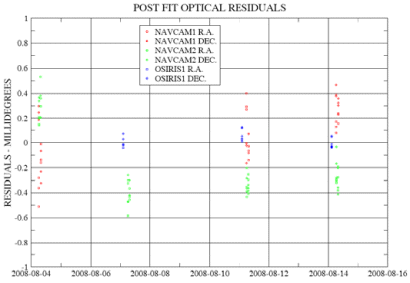 |
|
Figure 3. Post fit residuals of the optical data on 4, 7, 11 & 14 August for the three cameras (red/green: NAVCAM A/B, blue: OSIRIS) |
The data from the optical navigation campaign are, in an ESA first, fed into the orbit determination of the Rosetta spacecraft and used to fine-tune its trajectory towards the asteroid. The plots below show the situation in the target plane of the 5 September fly-by, with the relative positions of Rosetta and asteroid Steins.
Spacecraft
Payload
All instruments are currently OFF with the exception of OSIRIS which is permanently ON and is used to acquire images of asteroid Steins for the navigation campaign.
ALICE
The instrument is OFF.
CONSERT
The instrument is OFF.
COSIMA
The instrument is OFF.
GIADA
The instrument is OFF.
MIDAS
The instrument is OFF.
MIRO
The instrument is OFF.
OSIRIS
The instrument is permanently ON and is used to acquire images of asteroid Steins and the background stars. Operations of the instrument proceed flawlessly.
ROSINA
The instrument is OFF.
RPC
The instrument is OFF.
RSI
The instrument is muted.
VIRTIS
The instrument is OFF.
Lander Philae
The instrument is OFF.
SREM
Since DoY 184/2008 the accumulation settings are configured for active cruise mode.
Future Milestones
The cruise phase continues towards asteroid Steins which will be encountered early September 2008. Spacecraft activities continue to be focused on the operations required for the optical navigation campaign (until 4 September), with the spacecraft now at ~15.7 million km from the asteroid. Both the navigation cameras (NAVCAMs) and the OSIRIS instrument will continue taking images to feed the orbit determination process.
In week 34 (18-24 August) the first scientific observation will take place with the Steins light curve characterisation by OSIRIS.
Trajectory correction manoeuvres will be executed as required by the fly-by operations.
---
Legal disclaimer
This report is based on the ESOC mission operations report, WOR #102. Please see the copyright section of the legal disclaimer (bottom of this page) for terms of use.

